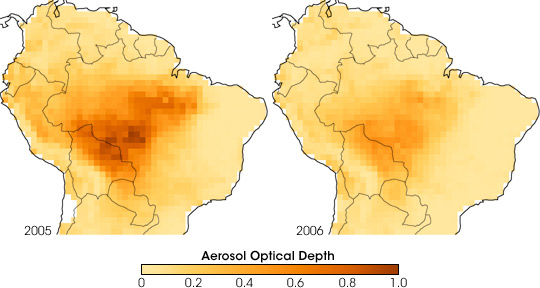


In 2005, at the tail end of a multi-year dry spell, the annual dry season in the Amazon south of the equator ballooned into an unrelenting drought. Agricultural fires, now a fixture on the Amazon frontier from August through mid-October, invaded adjacent forests on a large scale. Thick smoke hung over the forest off and on for months.
This pair of images illustrates the amount of smoke that the Moderate Resolution Imaging Spectroradiometer (MODIS) on NASA’s Terra satellite observed in the Southern Amazon dry season (August-November) in 2005 (left) and 2006 (right). The maps show aerosol optical depth, the sensor’s estimate of the transparency of the atmosphere. Low optical depth (yellow) means the atmosphere was relatively clear (transparent), while high optical depth (dark brown) means the atmosphere was very smoky (opaque). Smoke concentrations are higher in the southern Amazon, the forest’s agricultural frontier. The Andes Mountains along the west coast of South America keep the smoke over the lowlands.
The dramatic difference between 2005 and 2006 was documented in an analysis led by Ilan Koren of the Weizmann Institute of Science, working with colleagues at NASA’s Goddard Space Flight Center and the Brazilian Center for Weather Forecasting and Climate Studies. The team used fire data from a National Oceanic and Atmospheric Administration (NOAA) satellite collected between 1998 and 2006, and smoke observations from MODIS between 2000 and 2006. They discovered that since 1998, the number of dry season fires and smoke had significantly increased, with a peak in 2005. In response, scientists, government regulators, and civilian fire monitoring agencies teamed up in 2006 to provide better fire monitoring and prevention.
The reduction in fires and smoke was short-lived, however. When 2007 data became available, Koren updated the analysis: smoke and fires hit record-high levels. To learn more about trends in fires and smoke in the Amazon in the past decade, please read the feature story Amazon Fires on the Rise.
Maps by Robert Simmon, based on MODIS data from Ilan Koren. Caption by Rebecca Lindsey.